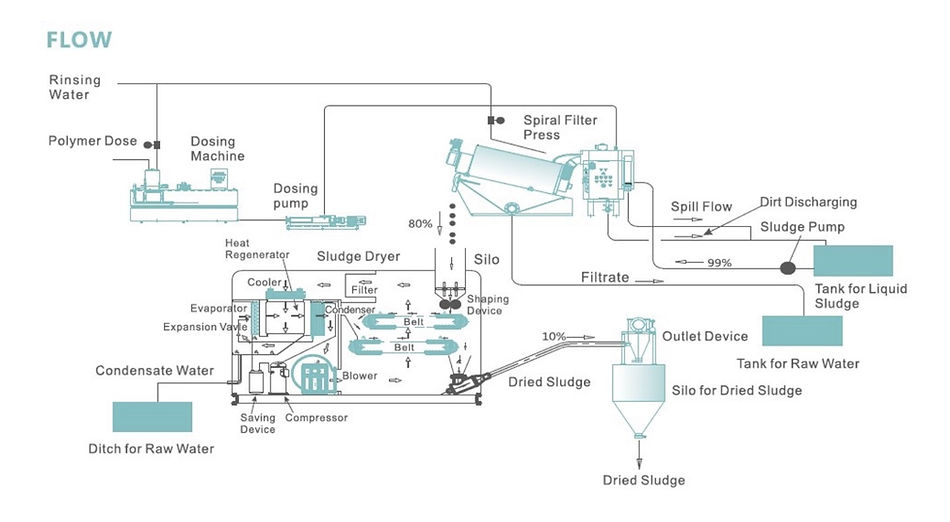
SLUDGE DRYING
STEP 2 + 3: Innovative Sludge Drying
Sludge
STEP 2 + 3 Innovative Sludge Drying
USA Sludge is a High-Tech Enterprise devoted to dehumidification heat pump sludge drying and destruction.
This new line of dehumidification heat pump sludge dryers are the most advance sludge drying machines in the world.
USA Sludge has broken through the difficulties and the high costs associated with traditional gas drying equipment by implementation of a fin-type regenerative cycle with advance slitting, combined with double and triple effect heat pump cycling which dramatically lowers the cost of sludge drying by reusing the heat that would normally be discarded in a traditional sludge drying system.
This high-tech drying system has a small footprint, effectively treats many different kinds of sludge, requires no odor control equipment and doesn’t require an fossil fuel emissions permit.

THE NEW SOLUTION
PFAS will forever change the way biosolids and sludge is handled.
DIGESTING
Once PFAS is attached to the sludge we can then go ahead and dewater and dry the solids. We can treat digested or undigested sludge but we believe digested sludge or biosolids with PFAS may cause problems downstream in the gas line if the digester gas is not burned on site at a suitable temperature to destroy the PFAS compounds in the moisture stream of the digester gas. Digesting sludge is necessary to stabilize biosolids for land application per the EPA 503 rules but if we are “baking” dried biosolids then digesting only serves the purpose of reducing the volume of solids to be baked.
DEWATERING
Dewatering sludge or biosolids with PFAS can be done the same way as treatment plants do now. Centrifuges and belt presses can be used to remove 40% of the water from the sludge without harm to operators because the sludge is not being thermally treated. Almost all sludge or biosolids are land applied or sent to the landfill but that will soon change. The days of taking sludge to a landfill or land application are numbered because it will be assumed that the sludge or biosolids has dangerous PFAS Chemicals...which most treatment plants already have.
Since the (Wet) or dewatered biosolids can not be disposed of via a landfill or land application then the solids will need to be dried. EPA 503 regs specify certain drying criteria for Class A and Class A EQ land application but those criteria will be a thing of the past because of PFAS legislation. Composting, Open Air Drying, and Forced Air Drying using oil or natural gas will not be permitted because of the moisture content of the air leaving the dryer. The only safe way of drying sludge or biosolids will be by dehumidifying a Hot Box full of sludge where no air can escape. This leaves 95% of the dryers on the market unusable.
PILOT SYSTEM
Our pilot system is designed to treat up to 15 wet tons a day of sludge or biosolids. We have a multi drying system that can treat 75 wet tons a day at 20% solids per machine and be coupled in groups of 8 to dry 600 wet tons a day to 80% solids.
These heat pump dryers are self-contained, insulated, closed loop systems where the air in the dryer is not released out of the drying cabinet making them the most energy efficient dryers in the world. These units dry the sludge using the heat pump cycle instead of burning fuel oil, or natural gas. Solar PV Panels can be installed, and grid tied to generate the electricity needed to operate the heat pump cycle and the moisture released from the organic cell is condensed and sent back to the headworks.
Encore Sludge
PFAS Treatment System
Project Entity
Project Description
Project System
System Sludge Inlet
System Outlet Sludge
Project Designer

Anyone
PFAS Drying Plant
PFAS In-situ treatment/sludge dewater/drying.
500,000 Gallons a day at 2% solids (40 Dried Tons)
Approximately 40 Tons of dried solids per 24-hour day.
USA Sludge

HOW IT WORKS
Total Sludge Drying System Overview
The total sludge treatment system consists of two integrated modules that receive inlet sludge from the current sludge processing stream at 1.0 – 5.0 % solids. The treatment system then dewaters and dries the sludge up to 90% solids in a slow moving all-in-one process creating a burnable solid. The system uses a heat pump, powered by electricity, to dry the sludge from 20% solids up to 90% solids.

Drying Overview
Below is a schematic of the USA Sludge Dryer. The dehumidification heat pump dries the wet sludge to dried Class A Fertilizer. The hot air and the condensate water are captured within the system.
There are no odor issues when using this closed cabinet drying system. The heat transferred from the compressor and fan motor is dissipated using a fan coil unit. The condensate water is captured and can be reused or recycled to the headworks of the treatment facility.
The dehumidification heat pump used in the proposed USA Sludge dryer utilizes the refrigeration principal to cool and dehumidify hot wet air. Through the heat pump principal, the heat pump recycles the latent heat released from steam congealing to water liquid. A dehumidification heat pump is equal to the dehumidification process (moisture removal or moisture dehumidifying) plus a heat pump process (energy recycling). A dehumidification heat pump can internally collect all the latent heat and sensible heat during air exhaust, bringing no waste heat to the outside.
The evaporation of sludge moisture absorbs latent heat; and the condensation of the generated vapor on the heat pump cycle releases latent heat. The evaporation process absorbs the same quantity of latent heat that the condensation process produces, according to the laws of thermodynamics and the law of conservation of energy. As a result, the drying process does not require additional heat capacity, resulting in the reduction of energy costs. The energy consumed during the process is only the electricity needed to operate the compressors and the air handlers.




